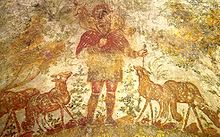
Catacombs of Domitilla edit
The Catacombs of Domitilla are an underground Christian[1] cemetery that were named after the Domitilla family that had initially ordered them to be made[2] and are located in Rome, Italy[3]. They are situated over 16 meters underground about 2 kilometers from the south of Appia Antica[4] (Appian Way) and spans 15 kilometers in distance.[4]They were actively used as a cemetery from around years first through fifth centuries CE[4] and were rediscovered in 1593 by Antonio Bosio, an Archaeologist.[5] They include more than 26,000 tombs.[5] More recently they have been restored using lasers giving a much clearer view of the images on the walls.[2] Unlike other Roman catacombs, it still has remains of humans.[4]
Renovation edit
The catacombs are composed of tufa, a form of limestone that is porous. [4][2] Finishing in 2017, restorers used lasers to help restore two rooms[1]. The restorers worked to remove layers of algae, smoke deposits, and a chalky substance[1]. What was revealed were both pagan and Christian inspired frescoes[4]. So far, only 12 out of around 70 rooms have been restored.[6]
Inside the Catacombs of Domitilla edit
Inside the Catacombs of Domitilla are images, some of which were revealed by the restoration, reflecting the life of bakers[2].grape vines, Jesus with the apostles, Noah's ark, and Daniel with the lions[2]. Other biblical figures in the various cubicula include the Virgin Mary with child[7], Adam, Eve, Jonah, The Good Shepard, a young man dressed as a cardinal with apostles Peter and Paul.[8] Non-biblical, or pagan, figures include representations of Spring and Summer in the form of females with wings, both pictured with attendants[8] and scenes depicting Orpheus[9] surrounded by birds, beasts and the sheep that typically accompany him[10]. There are also other images of mythological and while or tame beasts beyond the depictions of Orpheus[9]
- ^ a b c "Fresh Finds at Rome's Ancient Catacombs". Retrieved 2018-11-21.
- ^ a b c d e "Domitilla catacombs unveiled after years of renovation". Retrieved 2018-11-21.
- ^ LORENZI, ROSSELLA. "Not by Bread Alone - Archaeology Magazine". www.archaeology.org. Retrieved 2018-11-21.
- ^ a b c d e f Urzì, Clara; De Leo, Filomena; Krakova, Lucia; Pangallo, Domenico; Bruno, Laura (2016-12). "Effects of biocide treatments on the biofilm community in Domitilla's catacombs in Rome". Science of The Total Environment. 572: 252–262. doi:10.1016/j.scitotenv.2016.07.195. ISSN 0048-9697.
{{cite journal}}: Check date values in:|date=(help) - ^ a b "Fresh Finds at Rome's Ancient Catacombs". Retrieved 2018-11-21.
- ^ Squires, Nick (2017-05-30). "Laser technology uncovers 1,600-year-old Christian frescoes in Rome's biggest catacomb". The Telegraph. ISSN 0307-1235. Retrieved 2018-11-21.
- ^ Lasareff, Victor (1938). "Studies in the Iconography of the Virgin". The Art Bulletin. 20: 48 – via JSTOR.
- ^ a b Parker, John Peter (1877). The Archaeology of Rome: The Catacombs. London: Oxford. p. 72.
- ^ a b Huskinson, Janet (1974). "Some Pagan Mythological Figures and Their Significance in Early Christian Art". Papers of the British School at Rome. 42: 69 – via JSTOR.
- ^ Barker, Ethel Ross (1913). "The Symbolism of Certain Catacomb Frescoes-I". Burlington Magazine Publications Ltd. 24: 48 – via JSTOR.
This is a user sandbox of Ottangel. You can use it for testing or practicing edits. This is not the sandbox where you should draft your assigned article for a dashboard.wikiedu.org course. To find the right sandbox for your assignment, visit your Dashboard course page and follow the Sandbox Draft link for your assigned article in the My Articles section. |